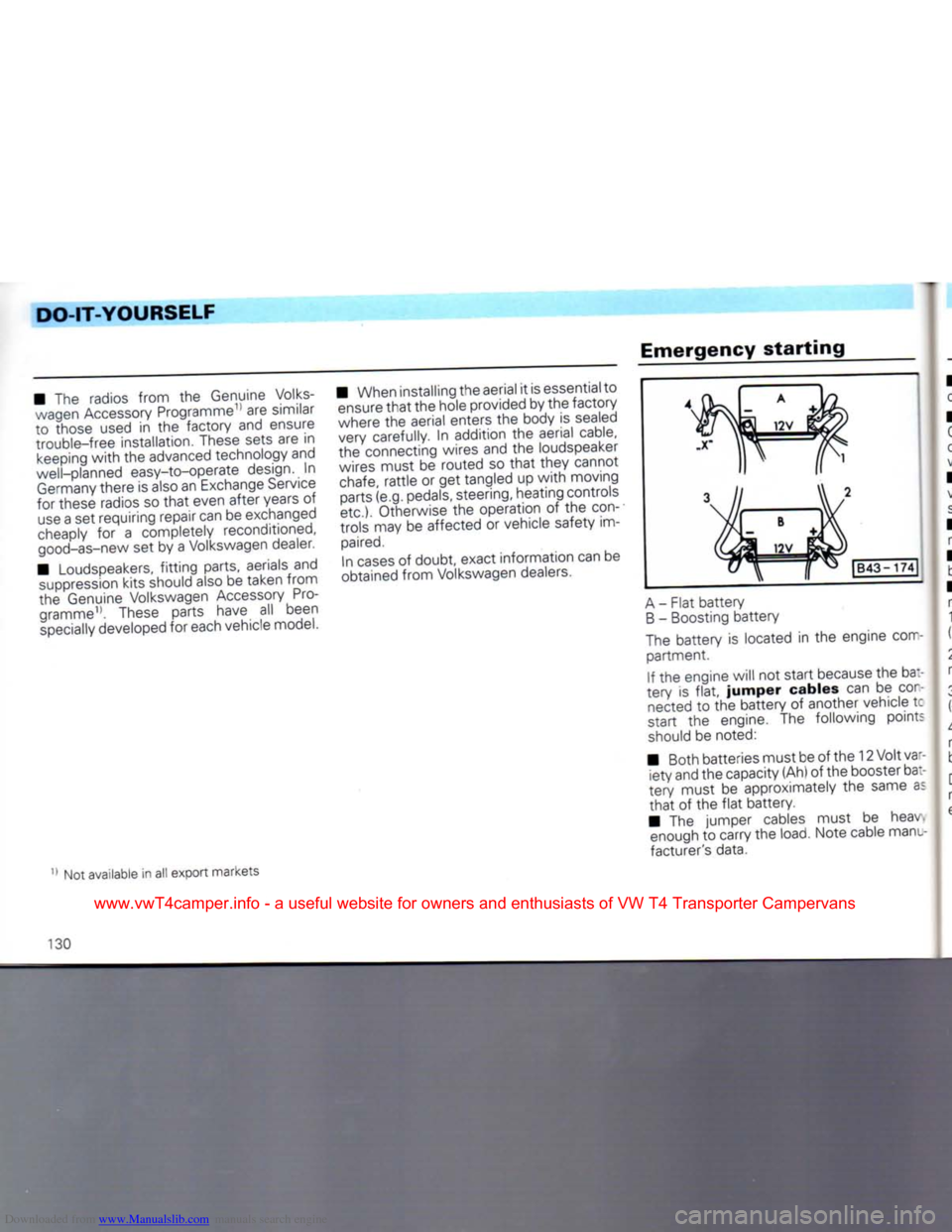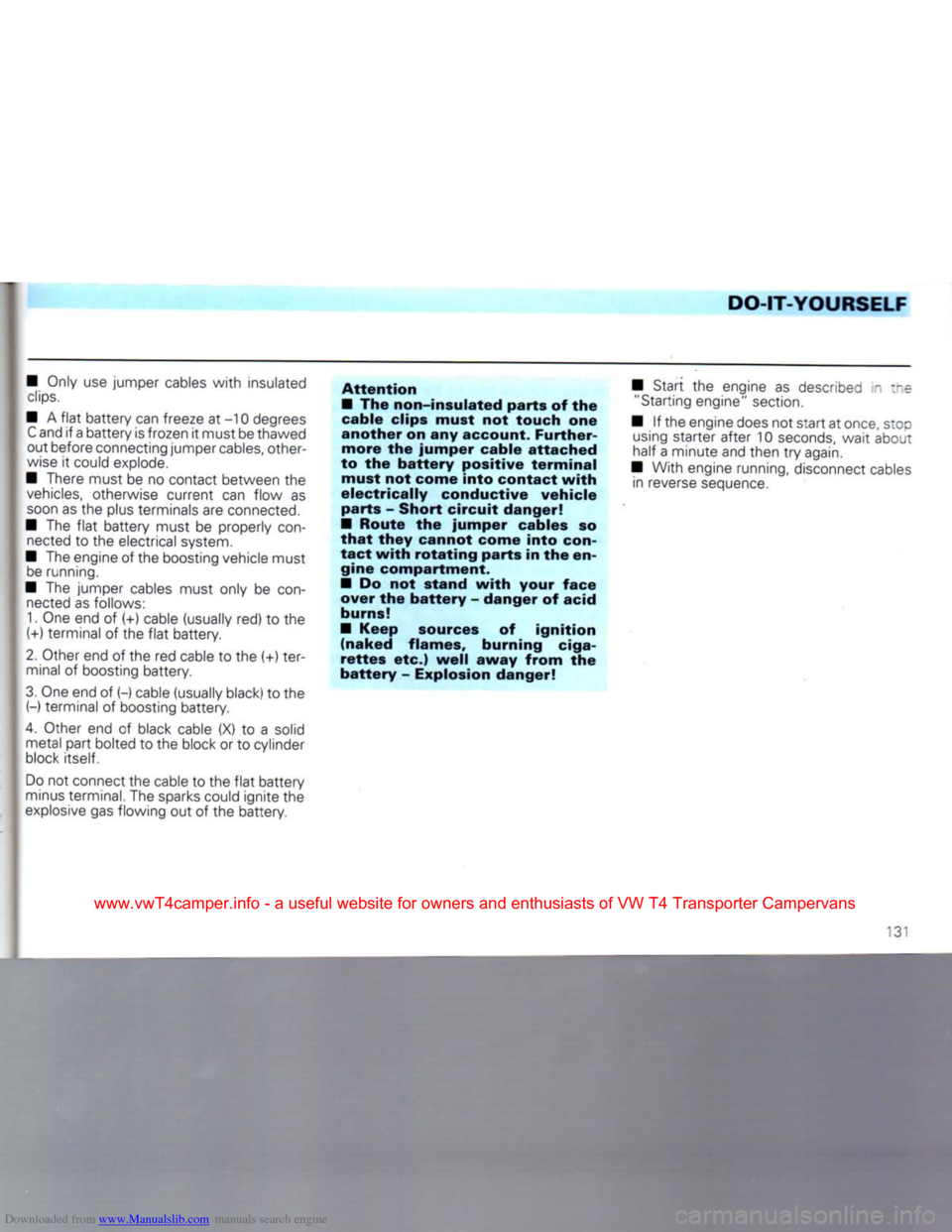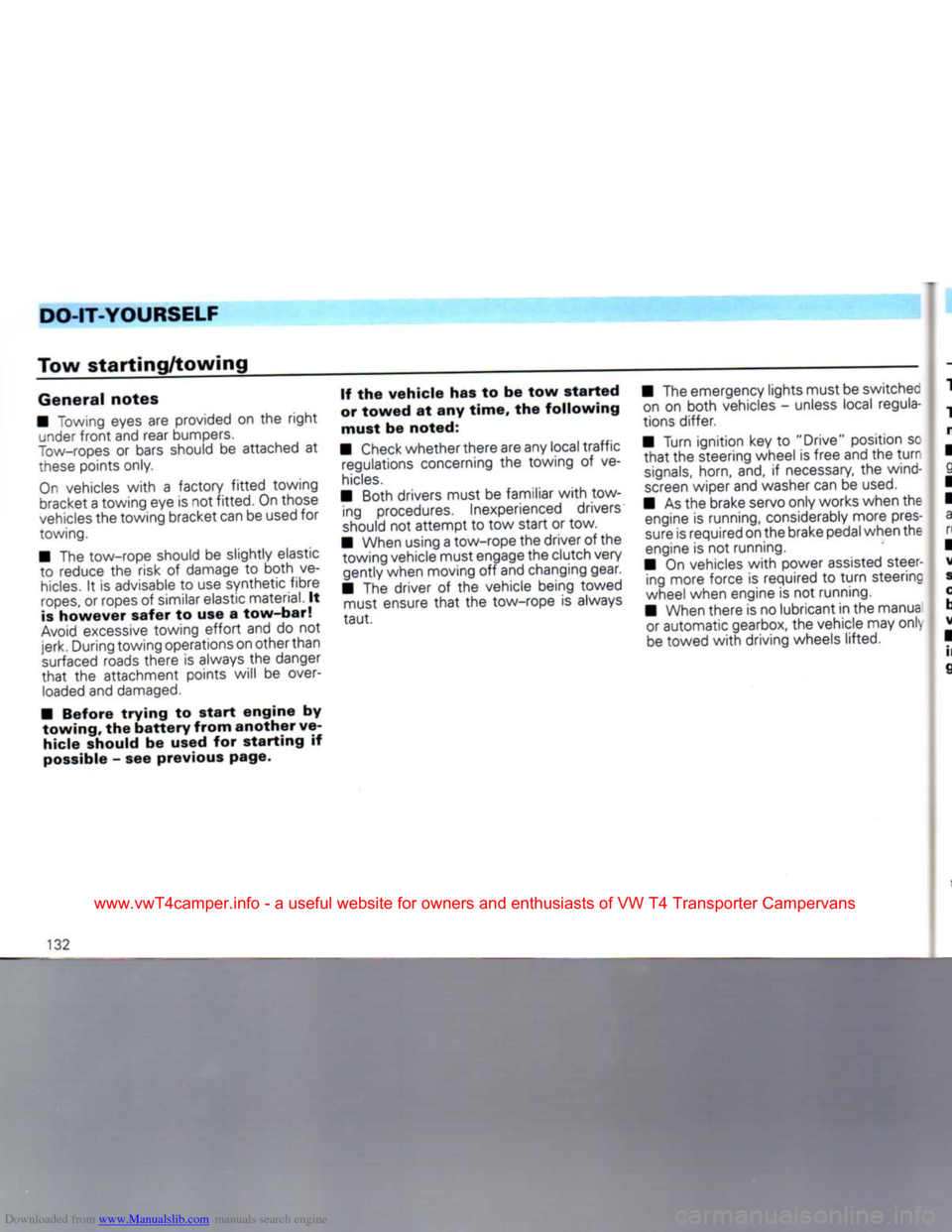1992 VOLKSWAGEN CARAVELLE Battery
[x] Cancel search: BatteryPage 132 of 164

Downloaded from www.Manualslib.com manuals search engine
DO-IT-YOURSELF
• The radios from the Genuine Volks wagen Accessory Programme11 are similar
to those used in the factory and ensure
trouble-free installation. These sets are in keeping
with
the advanced technology and
well-planned easy-to-operate design. In
Germany
there is also an Exchange Service
for these radios so
that
even after years of
use
a set requiring repair can be exchanged
cheaply
for a completely reconditioned,
good-as-new
set by a Volkswagen dealer.
• Loudspeakers,
fitting
parts, aerials and
suppression
kits should also be taken from
the Genuine Volkswagen Accessory
Pro
gramme11. These parts have all been
specially
developed for each vehicle model. • When installing the aerial it is essential to
ensure
that
the hole provided by the factory
where the aerial enters the body is sealed
very carefully. In addition the aerial cable,
the connecting wires and the loudspeaker
wires must be routed so
that
they cannot
chafe,
rattle
or get tangled up
with
moving parts (e.g. pedals, steering, heating controls
etc.). Otherwise the operation of the
con
trols may be affected or vehicle safety im
paired.
In
cases
of doubt, exact information can be
obtained from Volkswagen dealers.
Emergency
starting
|B43-
174[
A
- Flat battery
B
- Boosting battery
The battery is located in the engine com partment.
If the engine will not start because the ba:-
tery is
flat,
jumper
cables can be
con
nected to the battery of another vehicle tc
start the engine. The following points
should be noted:
• Both batteries must be of the 12 Volt var iety and the capacity (Ah) of the booster bat
tery must be approximately the same as
that
of the
flat
battery.
• The jumper cables must be heav enough to carry the load. Note cable manu
facturer's data.
Not available in all export markets
130
www.vwT4camper.info - a useful website for owners and enthusiasts of VW T4 Transporter Campervans
Page 133 of 164

Downloaded from www.Manualslib.com manuals search engine
DO-IT-YOURSELF
• Only
use
jumper cables
with
insulated
clips.
•
A
flat
battery can freeze
at
-10 degrees
C
and
if
a battery is frozen
it
must be thawed
out before connecting jumper
cables,
other
wise
it
could explode.
• There must
be no
contact between
the
vehicles,
otherwise current
can
flow
as
soon
as
the
plus terminals are connected.
•
The
flat
battery must
be
properly
con
nected
to the
electrical system.
• The engine
of
the boosting vehicle must be running.
•
The
jumper cables must only
be
con
nected as follows:
1. One end
of (+)
cable (usually red)
to the
(+)
terminal
of
the
flat
battery.
2.
Other end
of
the red cable
to the (+)
ter
minal
of
boosting battery.
3.
One end
of (-)
cable (usually black)
to the (-)
terminal
of
boosting battery.
4.
Other
end of
black cable
(X) to a
solid metal part bolted
to
the block
or to
cylinder
block itself.
Do
not
connect the cable
to
the
flat
battery
minus terminal. The sparks could ignite
the
explosive
gas flowing
out of the
battery.
Attention
•
The non-insulated parts of the
cable clips must not touch one
another on any account. Further more the jumper cable attached
to the
battery
positive terminal must not come into contact
with
electrically conductive vehicle parts - Short circuit danger!
•
Route the jumper cables so
that
they cannot come into
con
tact
with
rotating parts in the en gine compartment.
•
Do not stand
with
your face
over the
battery
- danger of acid
burns!
•
Keep sources of ignition (naked flames, burning
ciga
rettes
etc.)
well
away from the
battery
- Explosion danger!
• Start
the
engine
as
described
in the
"Starting engine" section.
•
If
the engine does not start
at
once, stop using starter after
10
seconds, wait about
half
a
minute and then
try
again.
• With engine running, disconnect cables in reverse sequence.
-.3'
www.vwT4camper.info - a useful website for owners and enthusiasts of VW T4 Transporter Campervans
Page 134 of 164

Downloaded from www.Manualslib.com manuals search engine
DO-IT-YOURSELF
Tow
starting/towing
General
notes
• "owing eyes are provided on the
right
under
front
and rear bumpers.
Tow-ropes
or bars should be attached at
these
points only.
On
vehicles
with
a factory
fitted
towing bracket a towing eye is not fitted. On those
vehicles
the towing bracket can be used for
towing.
• The tow-rope should be slightly elastic to reduce the risk of damage to both ve
hicles.
It is advisable to use synthetic fibre
ropes,
or ropes of similar elastic material. It
is
however
safer
to use a
tow-bar!
Avoid
excessive towing
effort
and do not
jerk.
During towing operations on other than
surfaced
roads there is always the danger
that
the attachment points will be over
loaded
and damaged.
•
Before
trying
to
start
engine
by
towing,
the
battery
from
another
ve
hicle
should be used for
starting
if
possible - see previous page. If the
vehicle
has to be tow
started
or
towed
at any
time,
the
following
must
be noted:
•
Check
whether there are any local traffic regulations concerning the towing of ve
hicles.
• Both drivers must be familiar
with
tow ing procedures. Inexperienced drivers
should
not attempt to tow start or tow.
• When using a tow-rope the driver of the towing vehicle must engage the clutch very gently when moving off and changing gear.
• The driver of the vehicle being towed must ensure
that
the tow-rope is always
taut.
• The emergency lights must be switchec
on on both vehicles - unless local regula
tions differ.
• Turn ignition key to "Drive" position sc
that
the steering wheel is free and the
turr
signals,
horn, and, if necessary, the wind
screen
wiper and washer can be
used.
• As the brake servo only works when the engine is running, considerably more pres
sure
is required on the brake pedal when the
engine is not running.
• On vehicles
with
power assisted steer ing more force is required to
turn
steering
wheel when engine is not running.
• When there is no lubricant in the manua or automatic gearbox, the vehicle may only
be
towed
with
driving wheels lifted.
132
www.vwT4camper.info - a useful website for owners and enthusiasts of VW T4 Transporter Campervans
Page 138 of 164

Downloaded from www.Manualslib.com manuals search engine
TECHNICAL
DESCRIPTION
Engine
• 4 stroke petrol/Diesel engine, trans
verse
installation
• 4/5 cylinders in-line
• Cast-iron cylinder block
• 5/6 bearing crankshaft
• Sheet metal sump
• Alloy cylinder head
• Valves operated via toothed belt and overhead camshaft
• Maintenance free valve gear
with
hy draulic tappets
• Cooling system filled for life of vehicle
• Radiator
with
separate expansion tank • Electric radiator fan controlled by ther-
moswitch
• Maintenance free electronic ignition
• Long-life spark plugs
• Optical and acoustic oil pressure warn ing
• Low maintenance battery
with
high starting capacity
• Long-life low maintenance V-belts
• Thermostatically controlled intake air preheating
• Dry air cleaner
with
paper element • Fuel
injection
engines
have fully
electronic engine management (combined
control of injection and ignition systems).
• Emission control system
with
Lambda probe on petrol engines (not in all Export
markets)
•
Diesel
engines
with
distributor injec
tion
pump
with
cold start aid,
filter
preheat
ing,
self-bleeding fuel system
• Long life exhaust system.
'36
www.vwT4camper.info - a useful website for owners and enthusiasts of VW T4 Transporter Campervans
Page 158 of 164

Downloaded from www.Manualslib.com manuals search engine
ALPHABETICAL
INDEX
A
Acceleration
figures 142
Accessories
117 Activated charcoal
filter
138
Additional heater 62
Additional water heater 67
Adjusting brake pressure regulator . . 155
Adjusting headlights 128 Adjusting washer
jets
108
Air
cleaner 100
Air
conditioner 57
Air
distribution 55
Alloy
wheels 91
Analog
clock 46
Anti-dazzle
inside mirror 13
Anti-freeze 101 Anti-locking brake system (ABS) .... 30
Arduous operating conditions 115
Armrests 21
Ashtrays
73
ATF
99
Automatic gearbox 32
Automatic wash plants 88
Auxiliary heater 63
Axle
loads 148
B
Battery 106
Belt height adjustment 16
Blower
55
Bonnet 94
Brake
fluid
104
Brake
servo 30
Brake
system 104
Brake
warning lamp 48
Brakes
29, 139
c
Capacities
153
Capacity
141
Care
of body 88
Care
of car 88
Catalyst
137
Cavity
preservation 92
Central
locking system 8
Cetane
Number 87
Changing
bulbs 124
Changing
front
turn
signal bulb 125
Changing
wheels 120
Chassis
number 154
Checks
when
filling
the
tank
160
Child
safety 18
Child
seats 18
Child-proof catch 9 Cigarette lighter 73
Cleaning
and anti-corrosion
treatment
of engine compartment 91
Clock
46
Cold
starting aid 38
Combined
weight 151
Compression
ratio
141
Consumption figures 143
Coolant
additive 101
Coolant
level 47, 102
Coolant
temperature - Gauge 41
Cooling
system 101
Cruise
control system 53
D
Dash
panel 4
Dashboard
and controls 4
Defrosting windows 56, 58
Diesel
fuel 87
Dimensions
152
Dip lever 52
Dipstick - Automatic gearbox 99
- Engine 97
Direction indicators 48
Do-it-yourself 118
Door
locks 9
Doors
9 Drawbar weight 83
Driver's seat 20
Driving abroad 115
Driving on holiday 115
Driving safely 78 Driving tips 76
E
Electric
socket 73
Electric
window
lifters
12
Emergency
lights 51
Emergency
starting 130
Emission
control system 137
56
www.vwT4camper.info - a useful website for owners and enthusiasts of VW T4 Transporter Campervans
Page 159 of 164

Downloaded from www.Manualslib.com manuals search engine
ALPHABETICAL
INDEX
Engine
-Code
letters 154
-Data
141
- Intervals of oil change 93
-Number
154
-Oil
96 - Oil capacity
1
53
- Oil change intervals 98
- Oil consumption 97
- Oil level 97
- Oil pressure 47
- Starting/stopping 37
Engine
compartment 95
Engine
compartment
light
72
Engine
number 154 Environment
- Activated charcoal
filter
738
-Battery
707
- Brake
fluid
705 - Care of car 88
- Coolant 103
- Driving environment consciously 79 - Driving
with
low emissions/noise 79
- Emission
control
system 737
- Engine oil 98
- Filling the
tank
85
-Fuel 86 - Maintenance 93
-Old oil 98 - Old
tyres
712 - Petrol vapour accumulator .... 738
-
Tyre
pressure
7
70
- Tyres 7 72
- Unleaded
fuel
86
- Washing the vehicle 89
F
Fan
103
Filling
the tank 85
Filter
preheating 87
First
aid kit 118
Fog
lights 51, 125
Folding
seat 25
Foot
mats 29
Fresh
air ventilation 56
Front axle load 148 Front seats 20
Fuel
86
-Additives
86, 87
-Consumption
79,143
- Filter 116
- Filter preheating 87 - Gauge 46
- Saving 79
Fuses
122
G
Gear
change marks 40, 77
Gear
lever 31
Gearbox
oil 99
Glove
box 74
Glow
plugs 38
H
Handbrake
31
Head
restraints 19
Headlight
beam control 50
Headlight
flasher 52
Headlight
washer system 54
Heated
rear window 51
Heating
55, 57
High
beams 48
Horn
4
I
Identification data 154
Ignition
lock 36
Increased
payload 149
Inertia
reel belts 16 Inside mirror 13
Inspection intervals 98
Installing seat 22
Instrument
lighting 50
Instruments 40
Interior
lights 72, 126
Intervals of inspection 93
Intervals of oil change 93
J
Jack
120
Jacking
points 120
Jumper
cable 130
157
www.vwT4camper.info - a useful website for owners and enthusiasts of VW T4 Transporter Campervans